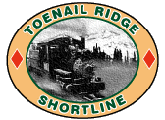
THE TOENAIL
RIDGE SHORTLINE
New Motive
Power for the Shortline
Written April 12th,
1999
Updated December
30th, 2001
The new Porter
on The Toenail Ridge Shortline started life in the workshops of the Bachmann
Industries assembly plant in Philadelphia, Pa.
It was originally
built as an oil-fired side-tanker but needs on the Ridge dictated a change
and after extensive modification it exited the Selbyville workshops as
a coal-fired tender loco.
The new incarnation hides a 9.6 volt nicad battery pack in its tender.
The tender is totally scratch-built from styrene
and carries a load of real coal. Even the back-up
light is scratch-built, around the carboard core from a fax paper roll.
Motive power
on the Toenail Ridge continues to evolve. The little Porter that lost its
side tanks and gained a tender has now gained a pony truck and has had
its headlight replaced with a very old-style kerosene type garnered from
a toy loco purchased from a local discount store.
The lantern
has been sprayed gold with its reflector sprayed with automotive chrome
paint. The main body of the lantern was then overpainted with Satin Black,
leaving the gold as highlights on the flag holders and chimney. The mounting
base is also from the toy loco.
This toy
is a battery powered old-time loco, about 1:32 in scale, 6-coupled, with
an excellent sound card feeding a one inch speaker in the boiler backhead.
Well worth the purchase price as its bell, diamond stack, domes, light,
Westinghouse brake and cowcatcher are up to good model standards, not to
mention the excellent working side-marker lights which are destined to
adorn my next caboose. One pair are already installed on the smokebox of
the 2-4-0 Porter loco, as is the Westinghouse.
The sound
card is already in the tender of the 2-4-0, control via a separate sub-miniature
switch in the front of the tender body.
The pony truck
was added following details in an article in an old Garden Railways magazine
written by Alan Olsen of the Acoma Central GR in Denver Co. I copied his
mod using the 4-wheel pony truck from a Bachmann 10-wheeler cut in half,
then added a long mounting arm laminated up from styrene strips and pivoted
the lot from a mount in front of the motor block. The arm is prevented
from dropping too far via a brass wire saddle bent to fit. Lead is glued
to the top of the axle mount to give some neccessary tracking.
The operation
of course required that the front pilot be lengthened, and a new pilot
apron fabricated. I lengthened the frame with Plastruct square tubing and
made the apron from Evergreen styrene sheet which I embossed with rivets
around the outer edges. An auxilliary air tank was mounted on the apron,
salvaged from an HO kit from years past, and a control valve was mounted
on the top of that using a dress snap painted red. New longer brass support
rods from the boiler to the cowcatcher were added, and the new pieces received
a generous covering of matt black, topped with dirty thinners to bring
out the highlights.
Got to be
the best weathering stuff around, dirty thinners. I use it to distress
balsawood too, gives an excellent instant 50 years-old appearance.
(For a good
example of the effectiveness of weathering with dirty thinners, see the
sides of my Class 'A' Climax
Update, December 30th, 2001
Haven't been really happy with the appearance of the cab, so I got
out the 1:20.3 scale rule and made a new one. You can see the results of
that modification here.